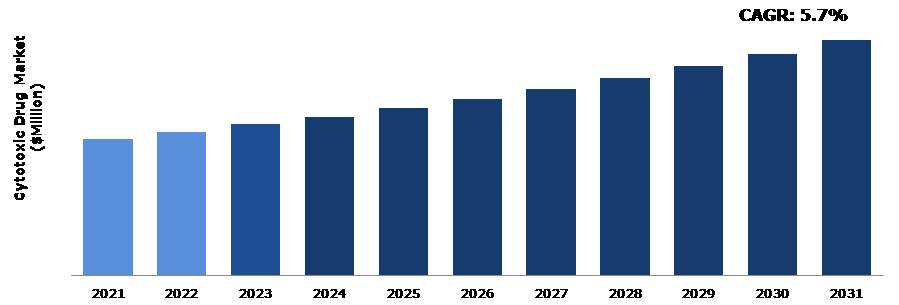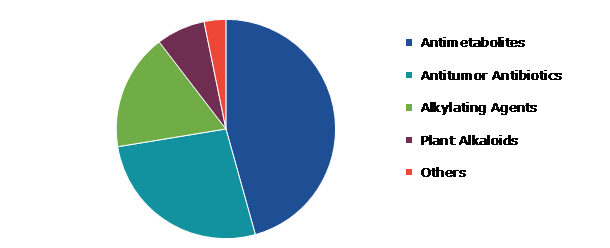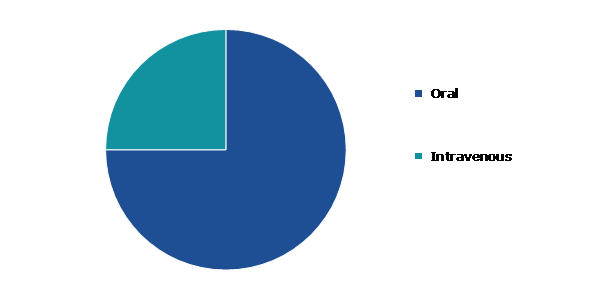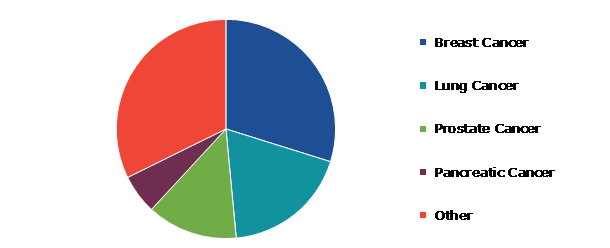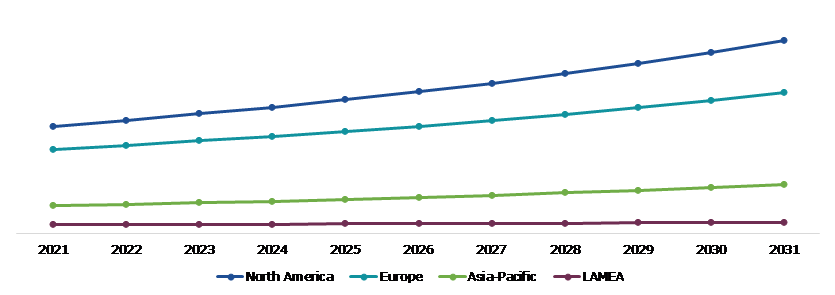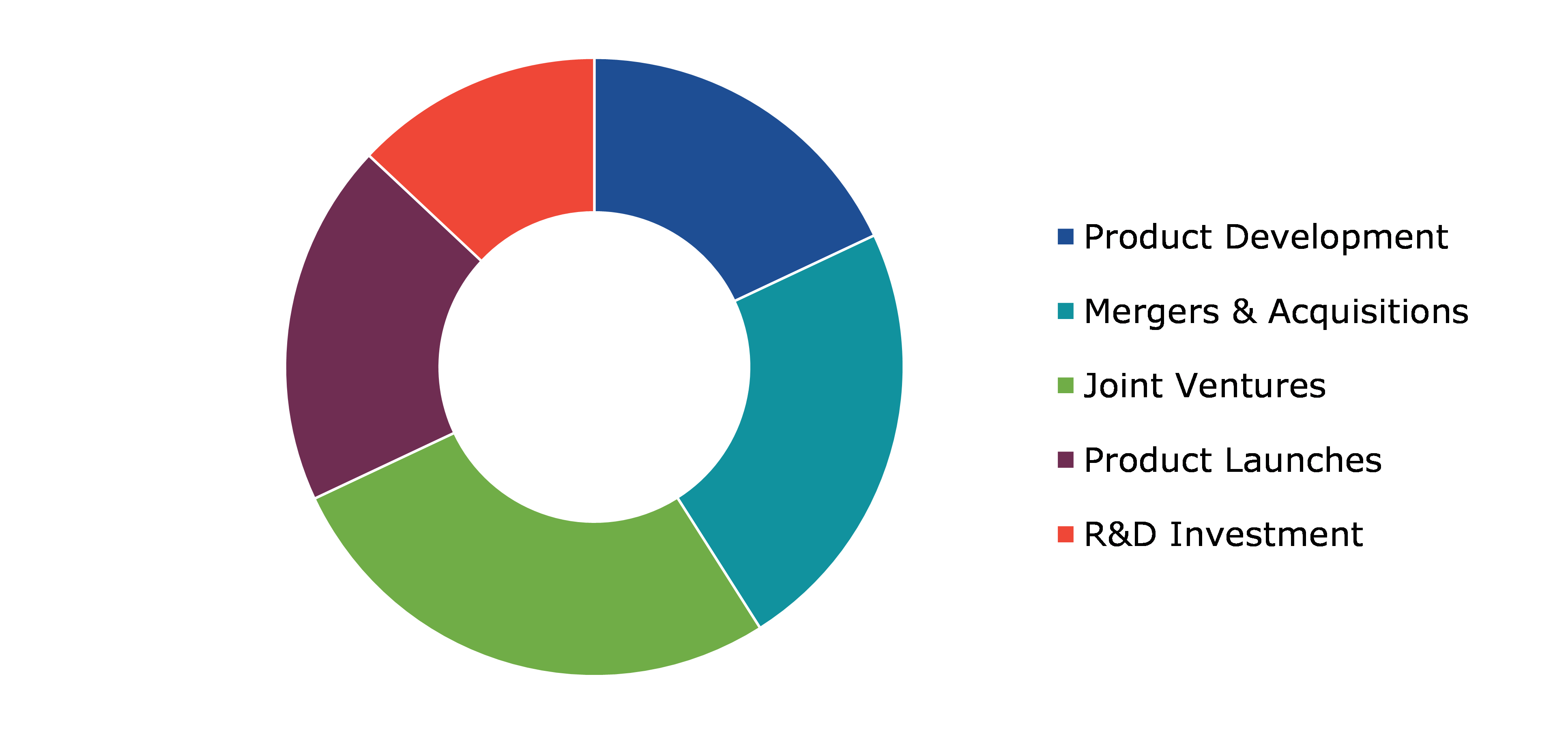Cytotoxic Drug Market Report
RA08551
Cytotoxic Drug Market by Drug Type (Antimetabolites, Antitumor Antibiotics, Alkylating Agents, Plant Alkaloids, and Others), Route of Administration (Oral and Intravenous), Application (Breast Cancer, Lung Cancer, Prostate Cancer, Pancreatic Cancer, and Other), and Regional Analysis (North America, Europe, Asia-Pacific, and LAMEA): Global Opportunity Analysis and Industry Forecast, 2022-2031
Global Cytotoxic Drug Market Analysis
The Global Cytotoxic Drug Market Size was $12,564.50 million in 2021 and is predicted to grow with a CAGR of 5.7%, by generating a revenue of $21,644.10 million by 2031.
Global Cytotoxic Drug Market Synopsis
Cytotoxic medicines are chemotherapeutic agents used in the treatment of cancer. These medicines function by targeting and killing rapidly dividing cancer cells, reducing or preventing cancer growth and spread. Cytotoxic medicines are commonly used to treat cancers such as leukemia, lymphoma, breast cancer, lung cancer, and ovarian cancer. The need for cytotoxic medications is predicted to rise as the global prevalence of cancer rises. The increasing prevalence of cancer is attributed to various factors, including aging population, unhealthy lifestyles, exposure to carcinogens, and environmental factors. For instance, in February 2021, according to the report published by World Health Organization, the number of new cancer cases is predicted to climb by almost 70% over the next two decades. The healthcare sector is concentrating on creating new and more potent cytotoxic medications in response to the rising incidence of cancer. The development of targeted therapies and immunotherapies that are more effective and have fewer side effects than traditional chemotherapy is projected to stimulate demand for cytotoxic medications in the coming years. Also, the rising focus on cancer screening programs and public health initiatives is likely to raise the need for cytotoxic medications in the coming years. Overall, the rising global frequency of cancer is projected to be a major driver of the cytotoxic medication market in the coming years.
The side effects associated with cytotoxic drugs can limit the adoption of these drugs in the treatment of cancer. Cytotoxic drugs work by targeting rapidly dividing cells, which include both cancer cells and normal healthy cells, leading to side effects that can range from mild to severe. Some of the common side effects associated with cytotoxic drugs include nausea, vomiting, hair loss, fatigue, anemia, and increased risk of infection. These side effects can significantly impact the quality of life of patients undergoing treatment and can also limit the adoption of these drugs by healthcare providers.
Advances in technology are leading to the development of more effective and targeted treatments for cancer, which is increasing the demand for cytotoxic drugs. The healthcare sector is concentrating on creating new and more potent cytotoxic medicines in response to the rising incidence of cancer. The development of targeted therapies and immunotherapies that are more effective and have fewer side effects than traditional chemotherapy is projected to stimulate demand for cytotoxic medications in the coming years. Also, the rising focus on cancer screening programs and public health initiatives is likely to raise the need for cytotoxic medications in the coming years.
According to regional analysis, the North America cytotoxic drug market generated the maximum revenue in 2021. In North America, the cytotoxic drugs market is expected to witness significant growth due to factors such as the increasing prevalence of cancer, a growing geriatric population, and the availability of advanced healthcare facilities.
Cytotoxic Drug Overview
Cytotoxic medications or cytostatics (also cytotoxic chemotherapy) include drugs used to destroy cancer cells. Cytotoxic medications impede cell division and in this way cause cancer cells to die. Cytotoxic medicines are carried in the bloodstream throughout the body. Cytotoxic medicines can be used to kill tumors, increase the results of surgery or radiotherapy, minimize metastases and alleviate cancer symptoms. Cytostatics have the ability to kill tiny tumors that have evaded detection in tests as well as work outside the major tumor. Cytotoxic medications impact all dividing cells, including those of healthy tissue. Yet, cancer cells are particularly susceptible to cytostatic because they frequently divide noticeably more quickly than normal cells. The impacts on normal cells are less pronounced and healthy cells also recover faster.
COVID-19 Impact on the Global Cytotoxic Drug Market
The COVID-19 pandemic has had a significant impact on the global cytotoxic drug market. The pandemic led to disruptions in the global supply chain, reduced patient visits to healthcare facilities, and delays in clinical trials, which contributed to a slowdown in the growth of the market. The major impact of COVID-19 on the cytotoxic drug market was seen in the disruption in the global supply chain. Many countries-imposed restrictions on the movement of goods and people, which led to delays in the production, distribution, and transportation of cytotoxic drugs. This led to shortages of essential drugs, and in some cases, increased prices for these drugs. Another significant impact of COVID-19 on the cytotoxic drug market was the reduction in patient visits to healthcare facilities. Many patients were reluctant to visit hospitals and clinics for fear of exposure to the virus, which led to a reduction in the number of cancers diagnoses and a delay in the initiation of cancer treatment. This led to a decline in the demand for cytotoxic drugs.
The Increasing Incidence of Cancer Globally to Drive the Market Growth
The market for cytotoxic medications is significantly influenced by the rising incidence of cancer on a global scale. Cytotoxic medicines are used in a type of chemotherapy that works by interfering with cancer cells' capacity to divide and develop. Cancer is a complicated disease that can be caused by a variety of factors, including genetic abnormalities, environmental exposures, lifestyle decisions, and aging. The World Health Organization (WHO) estimates that cancer caused 9.6 million deaths in 2018, making it the second largest cause of death worldwide. The incidence of cancer has been increasing worldwide due to several reasons including changes in lifestyle and environmental factors. Some of the risk factors for cancer include tobacco use, alcohol consumption, unhealthy diets, lack of physical activity, and exposure to carcinogens such as ultraviolet radiation, air pollution, and certain chemicals. As the incidence of cancer continues to rise globally, the demand for cytotoxic drugs is also increasing.
To know more about global cytotoxic drug market drivers, get in touch with our analysts here.
The High Cost of Developing Cytotoxic Drugs, Conducting Clinical Trials, and Obtaining Regulatory Approvals to Restrain the Market Growth
The high expense of creating cytotoxic medications, running clinical studies, and getting regulatory clearances may hinder the market's expansion. The drug development process for cytotoxic medications is frequently time-consuming and costly, requiring significant preclinical testing and numerous phases of clinical trials before the treatment can be licensed for use. This can impose a large financial burden on pharmaceutical companies and dissuade them from investing in the development of new cytotoxic medications.
Increasing Demand for Personalized Medicine and Targeted Therapies to Drive Excellent Opportunities
The growing demand for customized medicine and targeted therapies creates a tremendous opportunity for the cytotoxic medicines market to improve the efficacy and safety of chemotherapy drugs. Targeted medicines function by focusing on specific molecular defects in cancer cells, which can boost therapy efficacy while reducing damage to normal cells. The market for cytotoxic pharmaceuticals can benefit from breakthroughs in genetics and proteomics to identify novel targets for chemotherapy agents and develop more precise and effective cancer treatments. Personalized medicine advancements have also resulted in the creation of companion diagnostics, which can assist in identifying patients who are most likely to benefit from a given chemotherapy drug. Companion diagnostics can help ensure that chemotherapy drugs are prescribed to the patients who are most likely to respond to treatment, which can improve treatment outcomes and reduce the risk of toxicity.
to know more about global cytotoxic drug market opportunities, get in touch with our analysts here.
Global Cytotoxic Drug Market, by Drug Type
Based on drug type, the market has been divided into antimetabolites, antitumor, antibiotics, alkylating agents, plant alkaloids, and others. Among these, the antimetabolites sub-segment accounted for a dominant market share in 2021. The alkylating agents sub-segment is projected to have a dominant market share during the forecast period.
Global Cytotoxic Drug Market Size, by Drug Type, 2021
Source: Research Dive Analysis
The antimetabolites sub-segment generated the maximum revenue in 2021. Antimetabolites are a type of chemotherapeutic medication that inhibits the metabolic pathways required for cancer cell growth and division. These medications are used to treat a variety of malignancies, including leukemia, lymphoma, and solid tumors. The main reason for the high demand for antimetabolites is their widespread use in cancer treatment. Antimetabolites are considered to be the core of cancer chemotherapy, and they are frequently used in combination with other chemotherapy medicines and targeted therapies.
The alkylating agents sub-segment is projected to have a dominant market share during the forecast period. Alkylating agents are a subclass of chemotherapeutic medications that interfere with cell division by attaching to DNA strands. These medicines are used to treat a variety of cancers, such as ovarian, lung, and breast cancer. Alkylating drugs have a broad therapeutic spectrum and can be utilized to treat both hematologic and solid cancers. They are also effective when combined with other chemotherapeutic medications and targeted therapies, making them a diverse treatment choice. Also, the development of new alkylating agents and analogs is projected to contribute to the growth of the cytotoxic drug market.
Global Cytotoxic Drug Market, By Route of Administration
Based on route of administration, the market has been divided into oral and intravenous. Among these, the oral sub-segment accounted for a dominant market share in 2021.
Global Cytotoxic Drug Market Share, By Route of Administration, 2021
Source: Research Dive Analysis
The oral sub-segment accounted for a dominant market share in 2021. Oral cytotoxic drugs are administered orally, and they are absorbed through the gastrointestinal tract. They are commonly used in the treatment of various cancers, including breast, lung, and colorectal cancer. Oral chemotherapy medications can be self-administered at home, eliminating the need for frequent hospital visits and reducing the stress on patients and carers. This can also enhance patient compliance and adherence to treatment.
Global Cytotoxic Drug Market, By Application
Based on application, the market has been divided into breast cancer, lung cancer, prostate cancer, pancreatic cancer, and others. Among these, the others sub-segment accounted for a dominant market share in 2021.
Global Cytotoxic Drug Market Growth, By Application, 2021
Source: Research Dive Analysis
The others sub-segment generated the maximum revenue in 2021. Breast cancer, prostate cancer, and lung cancer are the most often diagnosed cancers. Other forms of cancers account for a large fraction of cancer cases globally. Also, the availability of a wide range of cytotoxic medications for the treatment of various types of malignancies is fueling the growth of this sub-segment. Cytotoxic medicines are used in combination with other chemotherapeutic treatments, targeted therapies, and radiation therapy to treat many forms of cancer. The availability of a variety of therapy alternatives can improve patient outcomes and survival rates.
Global Cytotoxic Drug Market, Regional Insights
The cytotoxic drug market was investigated across North America, Europe, Asia-Pacific, and LAMEA.
Global Cytotoxic Drug Market Size & Forecast, by Region, 2021-2031 (USD Million)
Source: Research Dive Analysis
The Market for Cytotoxic Drug in North America is the Most Dominant
The North America cytotoxic drug market generated the maximum revenue in 2021. With more than 1.8 million new cancer cases diagnosed each year, North America has one of the highest cancer incidence rates in the world. This has led to a strong demand for cytotoxic medicines, which are commonly utilized to treat many types of cancers. In addition, North America's healthcare system is highly developed, with superior medical facilities and access to the most recent technologies and treatment alternatives. This has enabled healthcare providers to deliver the best possible care to cancer patients, including the use of cytotoxic medications. The presence of key market players in the region, including pharmaceutical companies and research institutions, has contributed to the growth of the cytotoxic drugs market in North America.
Competitive Scenario in the Global Cytotoxic Drug Market
Investment and agreement are common strategies followed by major market players. For instance, in October 2021, Merck announced that the FDA has approved KEYTRUDA, Merck's anti-PD-1 therapy, in combination with chemotherapy, with or without bevacizumab, for the treatment of patients with persistent, recurrent, or metastatic cervical cancer.
Source: Research Dive Analysis
Some of the leading cytotoxic drug market players are Pfizer Inc., AbbVie, Inc., Johnson & Johnson, GlaxoSmithKline plc, F. Hoffmann-La Roche AG, Bristol-Myers Squibb Company, Sanofi, Novartis AG, Merck & Co. Inc., and Baxter.
| Aspect | Particulars |
| Historical Market Estimations | 2020-2021 |
| Base Year for Market Estimation | 2021 |
| Forecast Timeline for Market Projection | 2022-2031 |
| Geographical Scope | North America, Europe, Asia-Pacific, LAMEA |
| Segmentation by Drug Type |
|
| Segmentation by Route of Administration |
|
| Segmentation by Route of Application |
|
| Key Companies Profiled |
|
Q1. What is the size of the global cytotoxic drug market?
A. The size of the global cytotoxic drug market was over $12,564.50 million in 2021 and is projected to reach $21,644.10 million by 2031.
Q2. Which are the major companies in the cytotoxic drug market?
A. Pfizer Inc., AbbVie, Inc., and Johnson & Johnson are some of the key players in the global cytotoxic drug market.
Q3. Which region, among others, possesses greater investment opportunities in the near future?
A. The Asia-Pacific region possesses great investment opportunities for investors to witness the most promising growth in the future.
Q4. What will be the growth rate of the Asia-Pacific cytotoxic drug market?
A. Asia-Pacific cytotoxic drug market is anticipated to grow at 5.9% CAGR during the forecast period.
Q5. What are the strategies opted by the leading players in this market?
A. Agreement and investment are the two key strategies opted by the operating companies in this market.
Q6. Which companies are investing more on R&D practices?
A. Sanofi, Novartis AG, Merck & Co. Inc., and Baxter are the companies investing more on R&D activities for developing new products and technologies.
1.Research Methodology
1.1.Desk Research
1.2.Real time insights and validation
1.3.Forecast model
1.4.Assumptions and forecast parameters
1.5.Market size estimation
1.5.1.Top-down approach
1.5.2.Bottom-up approach
2.Report Scope
2.1.Market definition
2.2.Key objectives of the study
2.3.Report overview
2.4.Market segmentation
2.5.Overview of the impact of COVID-19 on Global cytotoxic drug market
3.Executive Summary
4.Market Overview
4.1.Introduction
4.2.Growth impact forces
4.2.1.Drivers
4.2.2.Restraints
4.2.3.Opportunities
4.3.Market value chain analysis
4.3.1.List of raw material suppliers
4.3.2.List of manufacturers
4.3.3.List of distributors
4.4.Innovation & sustainability matrices
4.4.1.Technology matrix
4.4.2.Regulatory matrix
4.5.Porter’s five forces analysis
4.5.1.Bargaining power of suppliers
4.5.2.Bargaining power of consumers
4.5.3.Threat of substitutes
4.5.4.Threat of new entrants
4.5.5.Competitive rivalry intensity
4.6.PESTLE analysis
4.6.1.Political
4.6.2.Economical
4.6.3.Social
4.6.4.Technological
4.6.5.Environmental
4.7.Impact of COVID-19 on cytotoxic drug market
4.7.1.Pre-covid market scenario
4.7.2.Post-covid market scenario
5.Cytotoxic Drug Market Analysis, by Drug Type
5.1.Overview
5.2.Antimetabolites
5.2.1.Definition, key trends, growth factors, and opportunities
5.2.2.Market size analysis, by region, 2021-2031
5.2.3.Market share analysis, by country, 2021-2031
5.3.Antitumor Antibiotics
5.3.1.Definition, key trends, growth factors, and opportunities
5.3.2.Market size analysis, by region, 2021-2031
5.3.3.Market share analysis, by country, 2021-2031
5.4.Alkylating Agents
5.4.1.Definition, key trends, growth factors, and opportunities
5.4.2.Market size analysis, by region, 2021-2031
5.4.3.Market share analysis, by country, 2021-2031
5.5.Plant Alkaloids
5.5.1.Definition, key trends, growth factors, and opportunities
5.5.2.Market size analysis, by region, 2021-2031
5.5.3.Market share analysis, by country, 2021-2031
5.6.Others
5.6.1.Definition, key trends, growth factors, and opportunities
5.6.2.Market size analysis, by region, 2021-2031
5.6.3.Market share analysis, by country, 2021-2031
5.7.Research Dive Exclusive Insights
5.7.1.Market attractiveness
5.7.2.Competition heatmap
6.Cytotoxic Drug Market Analysis, by Route of Administration
6.1.Oral
6.1.1.Definition, key trends, growth factors, and opportunities
6.1.2.Market size analysis, by region, 2021-2031
6.1.3.Market share analysis, by country, 2021-2031
6.2.Intravenous
6.2.1.Definition, key trends, growth factors, and opportunities
6.2.2.Market size analysis, by region, 2021-2031
6.2.3.Market share analysis, by country, 2021-2031
6.3.Research Dive Exclusive Insights
6.3.1.Market attractiveness
6.3.2.Competition heatmap
7.Cytotoxic Drug Market Analysis, by Application
7.1.Breast Cancer
7.1.1.Definition, key trends, growth factors, and opportunities
7.1.2.Market size analysis, by region, 2021-2031
7.1.3.Market share analysis, by country, 2021-2031
7.2.Lung Cancer
7.2.1.Definition, key trends, growth factors, and opportunities
7.2.2.Market size analysis, by region, 2021-2031
7.2.3.Market share analysis, by country, 2021-2031
7.3.Prostate Cancer
7.3.1.Definition, key trends, growth factors, and opportunities
7.3.2.Market size analysis, by region, 2021-2031
7.3.3.Market share analysis, by country, 2021-2031
7.4.Pancreatic Cancer
7.4.1.Definition, key trends, growth factors, and opportunities
7.4.2.Market size analysis, by region, 2021-2031
7.4.3.Market share analysis, by country, 2021-2031
7.5.Other
7.5.1.Definition, key trends, growth factors, and opportunities
7.5.2.Market size analysis, by region, 2021-2031
7.5.3.Market share analysis, by country, 2021-2031
7.6.Research Dive Exclusive Insights
7.6.1.Market attractiveness
7.6.2.Competition heatmap
8.Cytotoxic Drug Market, by Region
8.1.North America
8.1.1.U.S.
8.1.1.1.Market size analysis, by Drug Type, 2021-2031
8.1.1.2.Market size analysis, by Route of Administration, 2021-2031
8.1.1.3.Market size analysis, by Application, 2021-2031
8.1.2.Canada
8.1.2.1.Market size analysis, by Drug Type, 2021-2031
8.1.2.2.Market size analysis, by Route of Administration, 2021-2031
8.1.2.3.Market size analysis, by Application, 2021-2031
8.1.3.Mexico
8.1.3.1.Market size analysis, by Drug Type, 2021-2031
8.1.3.2.Market size analysis, by Route of Administration, 2021-2031
8.1.3.3.Market size analysis, by Application, 2021-2031
8.1.4.Research Dive Exclusive Insights
8.1.4.1.Market attractiveness
8.1.4.2.Competition heatmap
8.2.Europe
8.2.1.Germany
8.2.1.1.Market size analysis, by Drug Type, 2021-2031
8.2.1.2.Market size analysis, by Route of Administration, 2021-2031
8.2.1.3.Market size analysis, by Application, 2021-2031
8.2.2.UK
8.2.2.1.Market size analysis, by Drug Type, 2021-2031
8.2.2.2.Market size analysis, by Route of Administration, 2021-2031
8.2.2.3.Market size analysis, by Application, 2021-2031
8.2.3.France
8.2.3.1.Market size analysis, by Drug Type, 2021-2031
8.2.3.2.Market size analysis, by Route of Administration, 2021-2031
8.2.3.3.Market size analysis, by Application, 2021-2031
8.2.4.Spain
8.2.4.1.Market size analysis, by Drug Type, 2021-2031
8.2.4.2.Market size analysis, by Route of Administration, 2021-2031
8.2.4.3.Market size analysis, by Application, 2021-2031
8.2.5.Italy
8.2.5.1.Market size analysis, by Drug Type, 2021-2031
8.2.5.2.Market size analysis, by Route of Administration, 2021-2031
8.2.5.3.Market size analysis, by Application, 2021-2031
8.2.6.Rest of Europe
8.2.6.1.Market size analysis, by Drug Type, 2021-2031
8.2.6.2.Market size analysis, by Route of Administration, 2021-2031
8.2.6.3.Market size analysis, by Application, 2021-2031
8.2.7.Research Dive Exclusive Insights
8.2.7.1.Market attractiveness
8.2.7.2.Competition heatmap
8.3.Asia Pacific
8.3.1.China
8.3.1.1.Market size analysis, by Drug Type, 2021-2031
8.3.1.2.Market size analysis, by Route of Administration, 2021-2031
8.3.1.3.Market size analysis, by Application, 2021-2031
8.3.2.Japan
8.3.2.1.Market size analysis, by Drug Type, 2021-2031
8.3.2.2.Market size analysis, by Route of Administration, 2021-2031
8.3.2.3.Market size analysis, by Application, 2021-2031
8.3.3.India
8.3.3.1.Market size analysis, by Drug Type, 2021-2031
8.3.3.2.Market size analysis, by Route of Administration, 2021-2031
8.3.3.3.Market size analysis, by Application, 2021-2031
8.3.4.Australia
8.3.4.1.Market size analysis, by Drug Type, 2021-2031
8.3.4.2.Market size analysis, by Route of Administration, 2021-2031
8.3.4.3.Market size analysis, by Application, 2021-2031
8.3.5.South Korea
8.3.5.1.Market size analysis, by Drug Type, 2021-2031
8.3.5.2.Market size analysis, by Route of Administration, 2021-2031
8.3.5.3.Market size analysis, by Application, 2021-2031
8.3.6.Rest of Asia Pacific
8.3.6.1.Market size analysis, by Drug Type, 2021-2031
8.3.6.2.Market size analysis, by Route of Administration, 2021-2031
8.3.6.3.Market size analysis, by Application, 2021-2031
8.3.7.Research Dive Exclusive Insights
8.3.7.1.Market attractiveness
8.3.7.2.Competition heatmap
8.4.LAMEA
8.4.1.Brazil
8.4.1.1.Market size analysis, by Drug Type, 2021-2031
8.4.1.2.Market size analysis, by Route of Administration, 2021-2031
8.4.1.3.Market size analysis, by Application, 2021-2031
8.4.2.Saudi Arabia
8.4.2.1.Market size analysis, by Drug Type, 2021-2031
8.4.2.2.Market size analysis, by Route of Administration, 2021-2031
8.4.2.3.Market size analysis, by Application, 2021-2031
8.4.3.UAE
8.4.3.1.Market size analysis, by Drug Type, 2021-2031
8.4.3.2.Market size analysis, by Route of Administration, 2021-2031
8.4.3.3.Market size analysis, by Application, 2021-2031
8.4.4.South Africa
8.4.4.1.Market size analysis, by Drug Type, 2021-2031
8.4.4.2.Market size analysis, by Route of Administration, 2021-2031
8.4.4.3.Market size analysis, by Application, 2021-2031
8.4.5.Rest of LAMEA
8.4.5.1.Market size analysis, by Drug Type, 2021-2031
8.4.5.2.Market size analysis, by Route of Administration, 2021-2031
8.4.5.3.Market size analysis, by Application, 2021-2031
8.4.6.Research Dive Exclusive Insights
8.4.6.1.Market attractiveness
8.4.6.2.Competition heatmap
9.Competitive Landscape
9.1.Top winning strategies, 2021
9.1.1.By strategy
9.1.2.By year
9.2.Strategic overview
9.3.Market share analysis, 2021
10.Company Profiles
10.1.Pfizer Inc.
10.1.1.Overview
10.1.2.Business segments
10.1.3.Product portfolio
10.1.4.Financial performance
10.1.5.Recent developments
10.1.6.SWOT analysis
10.2.AbbVie, Inc.
10.2.1.Overview
10.2.2.Business segments
10.2.3.Product portfolio
10.2.4.Financial performance
10.2.5.Recent developments
10.2.6.SWOT analysis
10.3.Johnson & Johnson
10.3.1.Overview
10.3.2.Business segments
10.3.3.Product portfolio
10.3.4.Financial performance
10.3.5.Recent developments
10.3.6.SWOT analysis
10.4.GlaxoSmithKline plc
10.4.1.Overview
10.4.2.Business segments
10.4.3.Product portfolio
10.4.4.Financial performance
10.4.5.Recent developments
10.4.6.SWOT analysis
10.5.F. Hoffmann-La Roche AG
10.5.1.Overview
10.5.2.Business segments
10.5.3.Product portfolio
10.5.4.Financial performance
10.5.5.Recent developments
10.5.6.SWOT analysis
10.6.Bristol-Myers Squibb Company
10.6.1.Overview
10.6.2.Business segments
10.6.3.Product portfolio
10.6.4.Financial performance
10.6.5.Recent developments
10.6.6.SWOT analysis
10.7.Sanofi
10.7.1.Overview
10.7.2.Business segments
10.7.3.Product portfolio
10.7.4.Financial performance
10.7.5.Recent developments
10.7.6.SWOT analysis
10.8.Novartis AG
10.8.1.Overview
10.8.2.Business segments
10.8.3.Product portfolio
10.8.4.Financial performance
10.8.5.Recent developments
10.8.6.SWOT analysis
10.9.Merck & Co. Inc.
10.9.1.Overview
10.9.2.Business segments
10.9.3.Product portfolio
10.9.4.Financial performance
10.9.5.Recent developments
10.9.6.SWOT analysis
10.10.Baxter
10.10.1.Overview
10.10.2.Business segments
10.10.3.Product portfolio
10.10.4.Financial performance
10.10.5.Recent developments
10.10.6.SWOT analysis
Cancer is a harmful, complicated disease that affects millions of individuals worldwide. Cytotoxic drugs can be an effective weapon in the fight against cancer, but they are only one element of a comprehensive plan for preventing, detecting, and treating the disease.
The cytotoxic drug market relates to the pharmaceutical industry's manufacturing and sale of medications that are meant to kill or impede the growth of cells that divide quickly, especially cancer cells. Cytotoxic drugs, or cytostatics (sometimes known as cytotoxic chemotherapy), are drugs that are used to kill cancer cells. Cytotoxic drugs prevent the division of cells, which kills cancer cells. They are conveyed throughout the body by the bloodstream. Cytotoxic drugs can be used to eliminate tumours, improve the outcomes of surgery or radiotherapy, reduce metastases, and treat cancer symptoms.
Recent Trends in the Cytotoxic Drug Market
Immunotherapy is a sort of cancer treatment that works by increasing the body's immune system to combat cancer cells. It has been particularly successful in treating several cancers, including lung cancer and melanoma. While it is not a cytotoxic drug, it is frequently used in conjunction with cytotoxic drugs, and its massive adoption has an impact on the cytotoxic drug market. Moreover, despite increased competition from targeted medicines and immunotherapy, new cytotoxic drugs are continuously being researched and approved for use.
Newest Insights in the Cytotoxic Drug Market
As per a report by Research Dive, the global cytotoxic drug market is expected to grow at a CAGR of 5.7% and generate revenue of $21,644.10 million by 2031. The primary factors driving the growth of the market are the growing importance of cancer screening programmes and public health measures, as well as the anticipated rise in demand for cytotoxic drugs as the incidence of cancer increases globally. However, the high cost of developing cytotoxic drugs, carrying out clinical trials, and receiving regulatory approvals are expected to hinder the market growth.
The cytotoxic drug market in North America is expected to remain dominant in the coming years. The region's high revenue in 2021 was driven by the rising older population, rising cancer incidence, and accessibility to cutting-edge healthcare services. This has raised the demand for efficient cancer treatments, such as cytotoxic drugs, which are an important part of many cancer therapy regimens.
How are Market Players Responding to the Rising Demand for Cytotoxic Drug?
Market players are responding to the rising demand for cytotoxic drugs by investing in research and development to create new and more effective drugs. They are also investigating new manufacturing procedures in order to improve production efficiency and minimize costs.
In addition, market players are increasingly focusing on strategic partnerships and collaborations with other players in the industry to leverage their strengths and expand their reach. Some of the foremost players in the cytotoxic drug market are AbbVie, Inc., Pfizer Inc., Johnson & Johnson, F. Hoffmann-La Roche AG, GlaxoSmithKline plc, Bristol-Myers Squibb Company, Novartis AG, Sanofi, Baxter, Merck & Co. Inc., and others. These players are focused on implementing strategies such as mergers and acquisitions, novel developments, collaborations, and partnerships to reach a leading position in the global market.
For instance:
- In October 2021, Merck, an international corporation from Germany, announced that KEYTRUDA, a drug developed by Merck, had received FDA approval to be used in conjunction with chemotherapy, either with or without bevacizumab, to treat patients with metastatic, recurring, or persistent cervical cancer.
- In December 2021, Sun Pharmaceutical Industries, the largest medication manufacturer in India, announced the INFUGEM injection's approval on the US market for the treatment of cancer.
- In March 2022, Eli Lilly and Company, a pharmaceutical firm in the United States, launched an extensive response letter for sintilimab in combination with pemetrexed and platinum chemotherapy for the first-line treatment of individuals with nonsquamous non-small cell lung cancer.
COVID-19 Impact on the Global Cytotoxic Drug Market
The COVID-19 pandemic had an adverse impact on the global cytotoxic drug market. The pandemic caused interruptions in the worldwide supply chain, fewer patient visits to healthcare institutions, and delays in research studies, all of which contributed to the market's slowing growth. The primary impact of COVID-19 on the cytotoxic drug market was the disruption of the worldwide supply chain. Many countries enforced restrictions on the movement of goods and people, causing delays in the shipment, production, and transportation of cytotoxic drugs. This resulted in shortages of necessary drugs and, in certain cases, price increases. Many patients were reluctant to visit clinics and hospitals for fear of being exposed to the virus, resulting in fewer cancer diagnoses and a delay in cancer treatment initiation. These factors significantly hindered the market growth amidst the pandemic.
Personalize this research
- Triangulate with your own data
- Request your format and definition
- Get a deeper dive on a specific application, geography, customer or competitor
- + 1-888-961-4454 Toll - Free
- support@researchdive.com

